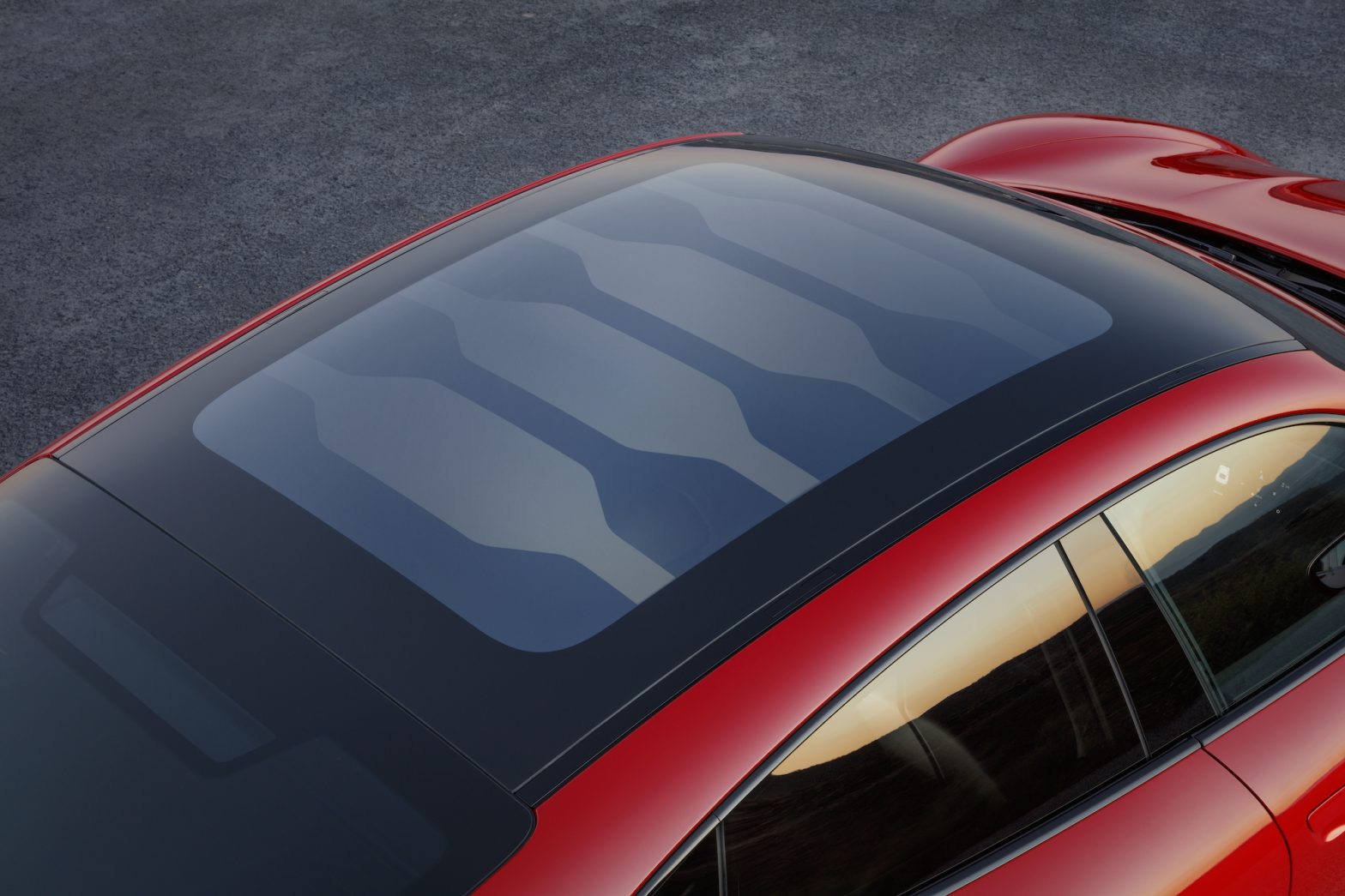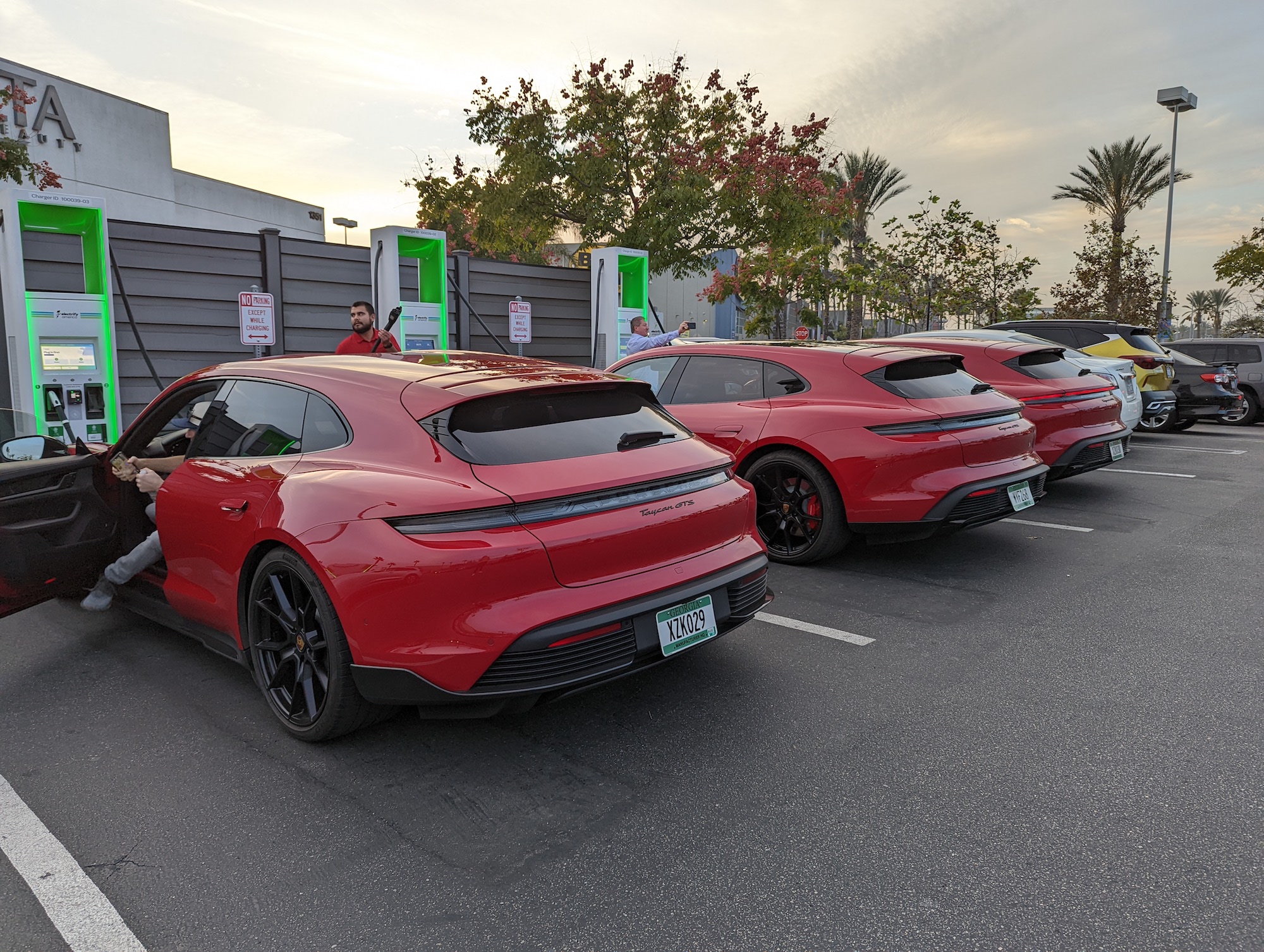All good things come to those who wait, and Porsche has reserved the most powerful version of its all-electric Taycan for last: the 2022 Porsche Taycan GTS and the wagon-style Taycan GTS Sport Turismo.
For those who want power, refined and sporty driving, and the ability to forgo gasoline for an all-electric powertrain, the Taycan GTS and Taycan GTS Sport Turismo both offer a solid blend of high-tech and powerful performance, which TechCrunch had a chance to test recently. GTS now comes in every model line Porsche offers, and the 2022 Porsche Taycan GTS and GTS Sport Turismo round out a total of 10 different Porsche Taycan offerings.
The upshot: The Sport Turismo GTS and its sedan sibling should be the benchmark for any luxury automaker trying to attract customers who want to make the transition from internal combustion to all-electric as smooth, seamless and reliable as possible. The drawback of course is that being a luxury vehicle puts the Taycan — and its many variants — out of reach for most people.
Before Porsche purists sharpen their knives about how the Taycan and its variants aren’t “true Porsches,” they might consider how the EV has resonated with consumers. The electric vehicle, first announced in 2019, has been a tremendous sales success for the company. Porsche sold 28,640 Taycan vehicles in the January-to-September period of 2021, outselling its flagship 911 sports car as well as the Panamera, 718 Boxster and 718 Cayman vehicles. (Porsche’s two most popular vehicles, the Cayenne and Macan, still outpaced the Taycan in sales.)
While the Taycan doesn’t come close to the number of Tesla Model 3 and Y sales reported this year, it has, so far, outstripped Tesla’s Model S and X sales. Tesla reports show that the company has delivered 13,214 Model S and Xs through the end of the third quarter.
The sales numbers suggest that Porsche’s $1 billion investment in the development of the Taycan have paid off. My time in these two latest and last variants verify that those development dollars were well spent. The 2022 Porsche Taycan GTS and Taycan GTS Sport Turismo are a sports sedan and wagon to be reckoned with.
On the road with the Porsche Taycan GTS Sport Turismo
Porsche unveiled the new Taycan GTS and Sport Turismo GTS at an event prior to the LA Auto show a few weeks ago, and we got seat time in both vehicles just after the unveiling in and around the Los Angeles area.
The Taycan GTS and GTS Sport Turismo sit below the line-topping 670-horsepower Turbo variant. Porsche says that Taycan GTS can accelerate from 0-60 miles per hour in just 3.5 seconds thanks to its 590-horsepower and 626 pound-ft of torque coming from a pair of permanent magnet synchronous motors at the front and rear of the car. That means that both variants of the GTS are all-wheel drive, though during normal driving, the balance of power is pushed down through the rear wheels.
That rear motor comes from the Porsche Taycan Turbo, and Porsche says that this makes the GTS more agile and responsive on the road.
The motors are powered by a 93.4 kWh battery pack on 800-volt architecture, in both vehicles. That allows the vehicle to fast charge from 5% battery power up to 80% in just 22 minutes, which we got to try out at a DC fast charger in a local Walmart parking lot.
I drove a bright red Taycan GTS Sport Turismo from downtown Los Angeles to Willow Springs (a one-way trip of around 90 miles) and back across the winding Angeles Crest Highway and Lake Hughes Road and back to downtown.
The heavier wagon-style GTS Sport Turismo never belied that it had that big ol’ backside hanging out. Agile, responsive, and comfortable in the variety of modes that ranged from the electron-sipping Range setting to Normal, Sport, Sport + and Individual, the GTS Sport Turismo is a luxurious and mighty powerful electric wagon.
Whether making a pass on a two-lane highway near Willow Springs or winding it over the sun-beaten concrete on the Crest, the GTS Sport Turismo lives up to its Porsche-touted moniker as the “sweet spot,” between the lower 4S and the top-of-the-line Turbo — and it’s specifically geared for those who want a sports car feel in an all-electric people hauler.
Porsche recalibrated the Porsche Active Suspension Management System, retuned the chassis, added an optional rear-steering system and adaptive anti-roll bars in the car we drove. In addition to this, the Taycan GTS and its wagon-y cousin get a new, optional, trick sunroof that goes from opaque to various stages of staggered panels, to clear, with the touch of a button. The roof is actually made of two panes of glass with liquid crystal nestled between, which creates a UV-blocking grey panel when fully activated or closed.
At the track with the Porsche Taycan GTS
More than likely, most Taycan GTS buyers won’t ever track their sedan, but, for that very small handful of people who do, there’s plenty to be impressed with. The Taycan GTS sedan still offers ample room for four passengers and all the bells and whistles of the Taycan GTS Sport Turismo, without the hatchback styling. Instead of hauling a wagon around the track at Big Willow, which honestly, sounds like a blast, I climbed into a Taycan GTS sedan for a 30-minute lead-follow stint.
The Taycan GTS comes with Porsche’s Track Precision app, which integrates with the new PCM 6.0 system in the car. Connect the app on your phone to the car and you can get detailed, real-time data on speeds, braking force, accelerator and brake input, and other information about just how you’re driving on the track. Mount your phone on your windshield and you’ll get the added bonus of a first-person POV video of the track that the app maps to everything from throttle input to steering angle and brake pressure.
Willow Springs is a notoriously gnarly track both because of its age and its sans-landmark, off-camber turns. On the track, the Taycan GTS remained firmly planted as I rocketed up to 120 mph on the front straight. Larger front brakes on the Taycan GTS (the same on the Sport Turismo) helped quickly haul the electric sedan down to more manageable speeds for the series of turns that run up the hill to a blind but sweeping left-hand turn and the vehicle felt connected and precise.
To say that the Taycan GTS is quick is an understatement. I drove Big Willow for the first time in a Lamborghini Huracán STO back in September. I don’t proclaim to be a race car driver, but, for context, my Porsche app-recorded lap time in the Taycan GTS sedan was only four seconds off of my best time in the STO — and that vehicle is specifically made for the race track. Suffice it to say, the Taycan GTS hauls on a closed course.
Charging the Porsche Taycan GTS Sport Turismo
Once our track time was over, I climbed back into the GTS Sport Turismo for the slog back to downtown Los Angeles. When I set out from the hotel that foggy Saturday morning, I started out with a fully charged battery and a range of 235 miles.
By the time we got to Willow Springs, after some spirited highway and canyon driving, the vehicle had around 130 miles of range left. The route was around 90 miles in total (one way) and I spent most of the drive toggling the wheel on the Race-Tex wrapped steering wheel, between Range, Sport + and Individual settings. These settings adjust the suspension, power and steering feel, and even the synthetic “engine sound” you hear on the Taycan GTS. The Individual setting, where I could separately set the steering feel and the ride to my liking, was my favorite.
Los Angeles traffic is perpetual, which can pose a challenge for some electric vehicles and their range. I stopped at a Porsche-appointed stopover to charge the Taycan GTS at one of the public Electrify America chargers in Burbank with around 70 miles of range left.
On a Saturday night, the place was absolutely packed with shoppers and EV chargers alike. There was only one DC fast charger, and according to the Porsche rep manning the charger to help journalists plug in, it had been out of service almost all day. When I arrived a Ford Mustang Mach-E was charging at the spot, so I pulled into one of the others that were vacant. To no EV owner’s surprise, the charger wouldn’t initiate for my GTS Sport Turismo. I tried three other chargers in the row, before finally returning to the DC fast charger, which, miraculously, connected and quickly charged my Taycan GTS Sport Turismo from 25% to 80% in just 20 minutes.
While this was a problem specific to the Electrify America charger, not Porsche, it is indirectly a problem for any automaker counting on this network of DC fast chargers to help it compete with Tesla and its proprietary Supercharger network. The Electrify America chargers at that location continually failed to recognize the vehicle I was driving. When other journalists showed up to charge, they too, had a similar issue and we all got to play charger leapfrog with a handful of electric motorcycles and cars to find a charger that would work.
User experience
While the charging infrastructure still needs a lot of work, the good news is that Porsche has made locating those chargers in its navigation system far easier than other electric automakers (with the exception of Tesla).
There are three different ways to find available chargers in the system. You can use the capable voice recognition to ask for local chargers, which will then pop up on the navigation system for you choose. You can also use the touchscreen to set search parameters (including the brand of EV charger and speed of charge) to search for chargers nearby.
Finally, you can use the Porsche app or the navigation in the infotainment system to set a route and the system will automatically find chargers along the route based on how much charge you want to have left when you arrive at your destination. The vehicles I drove were European-spec so I wasn’t able to try this setup myself, but one of the sedans at the track had some limited U.S-features available and a Porsche spokesperson walked me through the process.
In addition to being able to access these features via the center screen, Porsche’s new infotainment screen stretches across to the passenger side of the car and allows passengers to search for chargers, change stereo inputs and stations, and navigate (amongst other things) while the vehicle is under way. Most automakers lock out access to these features in their vehicles both from the driver and passenger seats when they’re moving, a “feature,” that’s absolutely infuriating when actively trying to navigate or find locations while moving. It’s not so in the Taycan GTS and Taycan GTS Sport Turismo, since both the driver and passenger can still interact with numerous features on the infotainment system while the vehicle is rolling.
The 2022 Porsche Taycan GTS and Taycan GTS Sport Turismo will be delivered to customers willing to shell out for the $110,000+ price tag by Q2 of 2022. Pricing starts at $131,400 (plus $1,350 for delivery) for the sedan and $133,300 for the Sport Turismo. And in true Porsche style, nearly everything can be customized to your liking. Both offer plenty of performance and style for the proverbial buck in sleek, sleeper packaging that offers a solid balance of technology and refinement for the enthusiast and their passengers.
The 2022 Porsche Taycan GTS, in any form, is truly an electric vehicle to be reckoned with.



